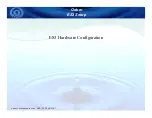
Charging the Hydraulic System
IMPORTANT
Air must be purged from the system to reduce the chance of
component damage.
When initially starting the hydraulic system with new or rebuilt components such
as motors or pumps, it is important that the hydraulic system is charged properly
to remove air from the system.
Note:
Flush the hydraulic system whenever there is a severe component failure
or the system is contaminated; refer to
Flushing the Hydraulic System (page
5–38)
.
1. Park the machine on a clean, level surface with the engine off. Lower and
lock the transport wheels (drive roller off ground).
2. Ensure that all of the hydraulic connections, lines, and components are
secured tightly.
3. Ensure that the hydraulic tank is full. Add the correct quantity and type of
hydraulic fluid if necessary; refer to the
Operator’s Manual
.
4. Check the motion control linkage for proper adjustment, binding, or damaged
parts.
5. Prime the hydraulic pump; refer to
Priming the Hydraulic Pump (page 5–41)
.
6.
Start the engine and run it at low-idle speed.
Note:
The transmission/hydraulic pump must pick up the hydraulic fluid and
fill the hydraulic system. If there is no indication of fill in 30 seconds, shut off
the engine and determine the cause.
7. After the hydraulic system starts to show signs of filling, press the motion
control pedals to rotate the drive roller right and left several times.
8. Ensure that the motion control pedals return to the N
EUTRAL
position when
released and adjust if necessary.
9. Operate the motion control pedals in the left and right directions. Make sure
the drive roller is turning in the proper direction and allow the drive roller
to turn slowly for ten (10) minutes.
10. Shut off the engine.
11. Operate the machine by gradually increasing its work load to full over a 10
minute period.
12. Stop the machine, check the hydraulic components for leaks and tighten
any loose connections.
13. Check the hydraulic fluid level in the hydraulic tank and adjust as necessary;
refer to the
Operator’s Manual
.
Note:
If new fluid shows any signs of contamination, flush hydraulic system
again until the fluid is clean; refer to
Flushing the Hydraulic System (page
.
Hydraulic System: Service and Repairs
Page 5–42
GreensPro
™
1240/1260
14211SL Rev A
Summary of Contents for GreensPro 1240
Page 4: ...Reader Comments Page 4 GreensPro 1240 1260 14211SL Rev A...
Page 8: ...Preface Page 8 GreensPro 1240 1260 14211SL Rev A...
Page 14: ...Safety Safety and Instructional Decals Page 1 6 GreensPro 1240 1260 14211SL Rev A...
Page 30: ...Specifications and Maintenance Special Tools Page 2 16 GreensPro 1240 1260 14211SL Rev A...
















































